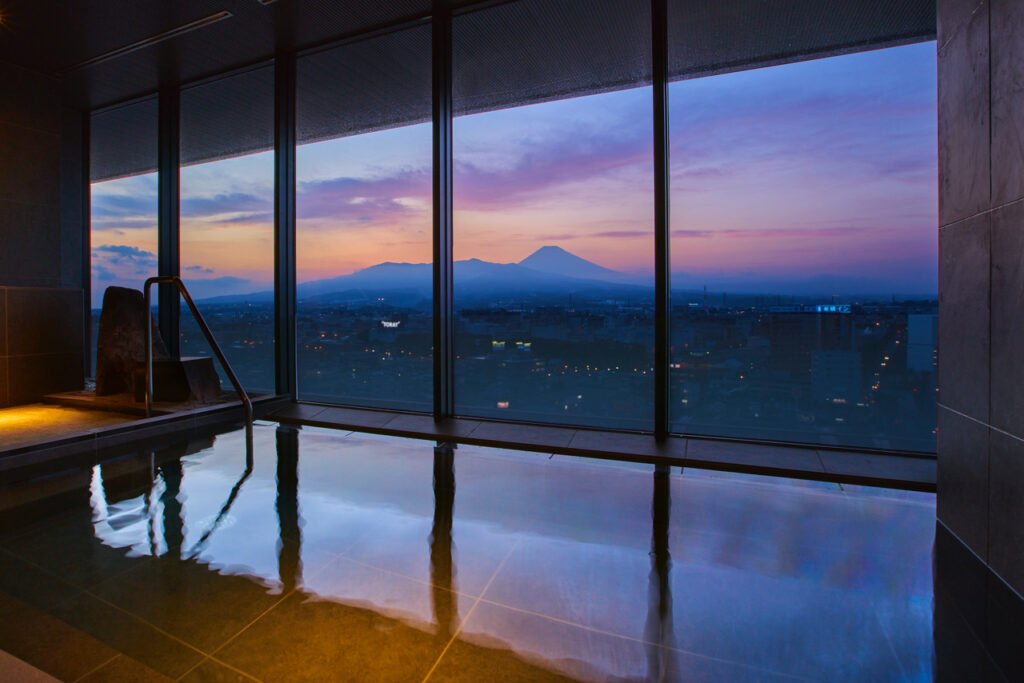by Vickie Lillo
The elderly Japanese woman and her daughter coddle next to me at Fujisan Mishima Tokyu’s makeshift, top-floor onsen. Together, we soak in the extreme warmth of the hotel’s panoramic bath admiring the view – the foothills of Hakone and the snow-capped and slightly simmering Mount Fuji, Japan’s most famous stratovolcano. In spite of the language barrier, the three of us communicate perfectly enough to jointly admire its beauty.
The island nation is quickly gaining a respectable reputation as a wellness mecca. Whether you opt to stay at a monastic retreat or traditional ryokan inn, sleeping on tatami floor-mats, Japan can accommodate the most discriminating, health-conscious traveler. From stress-reducing therapies to hiking and yoga. In fact, Zen Buddhism, a school of religion introduced to Japan during the 6th century, has infiltrated much of their culture, focusing on meditation to reach self-actualisation and enlightenment.
If devout introspection isn’t your modus operandi for relaxation, try visiting the lovely shrines and ancient temples instead. Applaud the gilt-leaf artisanry at Kyoto’s Kinkaku-ji (known as the Golden Pavilion). Appreciate the architectural beauty of the Nijūbashi Bridge overlooking the Imperial Palace. Be lulled into contentment traipsing through thousands of orange-red torii gates at Fushimi Inari.

Plus, there’s always ‘forest bathing’. Simply walking or sitting outside, surrounded by nature, listening to chittering birds and babbling brooks is another option. My husband Gustavo and I especially enjoyed the solitude of Ninomaru Garden inside the Nijo Castle complex, a U.N. World Heritage site. Even devoid of spring’s cherry blossoms and summer florals, the sago palms of winter, cloaked in straw sheeting, decorate these grounds, befitting the long-ago residence of Kyoto’s shogun. Up the road, and aways the antithesis to the frosty austerity at Ninomaru, the Arashiyama Bamboo Forest envelops us in its year-round verdure. It’s also where towering groves of bamboo lure hundreds of visitors along its trails.

To fully immerse yourself into the Japanese wellness culture, begin by sampling their culinary delights. Udon noodles and traditional sushi – rice soaked till sticky in rice-wine vinegar, paired with fish/vegetables, wrapped in seaweed. Get really daring, like we did in Osaka, and try the takoyaki which is fFried balls of battered octopus. Just watching the preparation is a delight in itself.
With wellness in Japan being all about ‘getting into the authenticity’ of the destination, Japan offers insight into many of its cultural norms. Classes in calligraphy, the visual art of lettering with a pen…classical koto (harp) performances on a Japanese zither…even tea ceremony participation. For this, Gustavo and I attempt to emulate Akiko, our master sensei (teacher), using the cha-sen (tea whisk) to whip the hot water and powdered green matcha into a bubbly froth. Three sips later, our teacups are empty. The bitter tang that remains on the tongue is slightly offset by the kashi, a sugary-sweet snack provided prior to the lesson.
Perhaps the best experience in Japan is dressing up in a kimono. Though often associated with the geisha, these exquisite garments are actually the national dress. Especially in Kyoto, former seat of the Imperial Court, where shops beckon with racks of gorgeous kimonos for rent. Outfitted in a turquoise-and-wine fabric, I emerged from the dressing room. My broad purple sash – an obi – keeps me squeezed into that frock tighter than a corset ever could. Expressly-designed white tabi socks allow my feet to slide into flip-flop-styled zōri sandals. My husband, in a burgundy yukata (summer kimono), sidles alongside. I grab his arm and we head out, toward Amida Hall, the main worship centre of Higashi Honganji Temple. One hour and dozens of photographs later, we return our kimonos, and I could breathe again.

But nothing speaks more to the wellness psyche of the Japanese than their penchant for the ‘bath’. Maybe it’s merely luxuriating in public footbaths, like those at the Hakone Open-Air Museum of sculptures. Or on the terrace at the volcanic zone of Ōwakudani, while gobbling a brimstone-blackened hard-boiled egg, cooked in the hot springs of ‘Hell Valley’. As the legend goes: for every consumed egg, your life extends by seven years. Apparently, Gustavo plans on outliving me by 21 years.
Sitting on the ‘Ring of Fire’s’ western edge, Japan’s landscape practically oozes with hydrothermal springs – onsens – rich in magnesium and sulfur. Catalyzing their spa culture and fascination with public bathing. Drawing on this naturally-heated groundwater, Osaka’s Spa World features themed rooms modeled after famed saunas and hot-tubs from around the globe. Despite the ‘entertaining’ vibe, traditional bathing etiquette must still be observed. It takes some ‘getting used to’, walking around with your bare derriere and privates hanging out.
If you’re shy, look for the ‘uninhabited’ zones – perhaps the Islamic stone hammam, the Singapore spa with highly-concentrated oxygen bubbles, or the dry-air salt sauna. I choose to laze a bit outdoors, in the Japanese mountain-stream individual basins, soothed by the air-currents’ cadence through the trees.
Gustavo joins me in the third-floor bedrock baths, where men and women, dressed in provided lounging attire, co-mingle. To sweat. Zinc ions from the stones balance female hormones and beautify skin. Negative ions promote blood circulation and activate cells. We ‘float’ on the Dead Sea of Israel, warmed by rock-salt, lavished by seven-colour lighting therapy and menthol-infused scents. In the Egyptian Rakuatsu, pyramid stones emit far-infrared rays from the furnace. This stifling sauna I nickname ‘the original sweat lodge’. While I cool down in Iceland’s Cold Wind, Gustavo moves on to the Russian Banya (steam bath) to perspire even more.
You’ll discover the need for these ‘urban’ onsens, after your ‘unplanned’ daily fitness regime. Dashing from shrine to shrine…schlepping your luggage through the streets…scaling thousands of stairs to reach the subways and trains. By evening, your limbs will be more than happy to sink into a reservoir of near-scalding water.
– – – – –
Vickie Lillo is a Toronto-based writer and regular contributor to Travel to Wellness.

